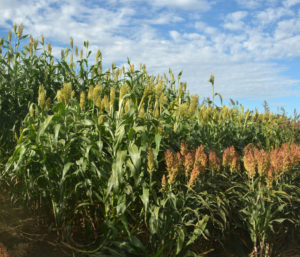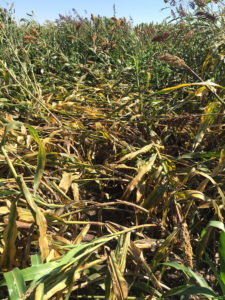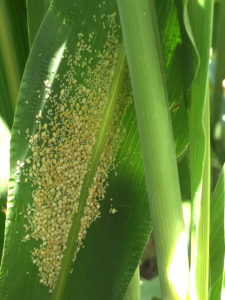Amarillo, Texas, USA
September 25, 2016
Every year is a learning year right now for Texas A&M AgriLife Extension Service entomologists and anyone else dealing with the sugarcane aphid, both on grain sorghum and forage sorghum in the Texas High Plains.

Dr. Ed Bynum, Texas A&M AgriLife Extension Service entomologist in Amarillo, explains sugarcane aphid treatments and results during a recent forage sorghum field day. (Texas A&M AgriLife photo by Kay Ledbetter)
“We have a lot more information about grain sorghum than we do on the forage sorghum,” said Dr. Ed Bynum, AgriLife Extension entomologist at Amarillo.
Bynum, participating in a recent forage sorghum turn-row meeting near Bushland, said the crops are pretty close to each other, the major difference being the grain sorghums are shorter and the forage sorghums are taller and have more leaf area.
“But I think the type of damage the sugarcane aphid is causing is basically going to be the same regardless of whether it’s forage sorghum or grain sorghum.”
What is known, he said, is the amount of yield loss is greater in grain sorghums when infestations become established in the whorl stage than during the flowering and grain-filling stages.

Forage sorghum plots with grain sorghum borders show the differences in heights and leaf canopy. (Texas A&M AgriLife photo by Kay Ledbetter)
“We know when infestations get started in the whorl stage and you don’t do anything to protect the sorghum, you can have as much as 80 to 100 percent yield loss in that grain sorghum,” Bynum said.
“So, I would expect that it would be similar to that in these forages. Looking at the forage sorghum plots, what was evident is where infestations were really heavy, they were not putting on the amount of grain as others that did not have as heavy an infestation.”
Bynum said specific data will be coming in after Dr. Jourdan Bell, AgriLife Extension agronomist in Amarillo, and her team measure the grain yield, silage yield and quality.

Sugarcane aphid infestations can cause lodging, in addition to yield loss. (Texas A&M AgriLife photo by Dr. Jourdan Bell)
While the biggest expected damage from the sugarcane aphid is the loss of grain yield, he said it also weakens the stalk. So in forage sorghums that grow taller, weak stalks could result in a lot of lodging.
Another thing worth noting, Bynum said, is the grain sorghum trials infested at the grain-filling and dough growth stages saw yield losses of only about 20 percent.
“So there is a lot of difference between when the sugarcane aphids begin to build up in the grain sorghums and also the forage sorghums, I believe,” he said. “The question is, what kind of management practices can you do to try to avoid the level of damage you get?”
After two years of infestations in the High Plains, he said they know the aphids generally are brought in from the South.
“They don’t overwinter north of Amarillo, or haven’t in the last two years, so we know that the aphids have to be blown back in here,” Bynum said.

Colonies of sugarcane aphids can establish at a rapid pace once a plant is infested and untreated. (Texas A&M AgriLife photo by Dr. Jourdan Bell)
In the South Plains, they begin infesting sorghums in the early part of June and populations build in July, he said. But infestations the last two years in the Amarillo area and north haven’t been seen until August and into September.
“Your management practices need to aim at avoiding the sugarcane aphids until you can get the forage sorghums at a later growth stage,” Bynum said. “I would think that if you can adjust your planting dates and plant earlier, you can get into the field and get the crop up and get it cut before you get the sugarcane aphid damage.”
The second part of the equation is controlling the sugarcane aphids, he said.
“What levels of control are you going to get when the sorghum is waist-high compared to when it is 5-feet tall or taller? We know the level of control is better if you can get better coverage within that canopy.”
Bynum said two aerial insecticide applications were made to the forage sorghum field plots. The first application was with Transform at a rate of 2 ounces per acre, a high rate, trying to get good control.
“They did get a good level of control, but because of the pockets of infestations and sorghums that were taller than others, they still had areas that didn’t get good control, so the aphids built back up,” he said.
A second application of Silvanto was made about two and a half weeks later, at a rate of 6 ounces, and again some plots had good control while others didn’t, Bynum said.
“It comes back to the amount of leaf canopy and it not allowing that chemical to get down into the plant,” he said. “Try to scout as early as you can and if you find sugarcane aphids, try to get an application on as early as possible. You don’t want to allow the population to build up and have to treat when plants are taller and there is more leaf area on the plant.”